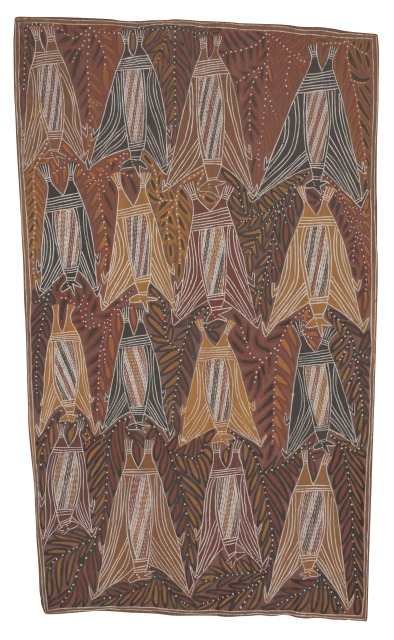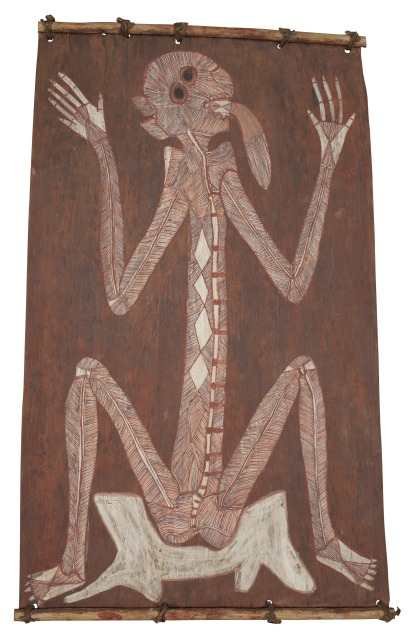Pieces From Australia's Great Aboriginal Bark Artists Now on Show at the National Museum of China
State of the Arts is our regular arts column whereby we take a look at the newest moves in Beijing's creative scene and highlight art news as well as exhibitions, artists, and openings that you should seek out.
Old Masters: Australia's Great Bark Artists is a product of collaboration between the Australian National Museum and the National Museum of China, with help from the Australian Embassy of Australia to China. The show’s presentation is rich in ethnographic and anthropologic detail, bringing together 122 specially selected objects from a collection of around 2,000 works housed at the National Museum of Australia in Canberra.
The exhibition highlights the work of master bark painters from Australia's northern region of Arnhem Land and the second exhibition of its kind to have focused on Aboriginal art in Beijing (the first took place at the National Art Museum of China). Compared to the last show back in 2010, the scale of this new collection makes for a great way to become acquainted not only with the style, mediums, and the artists that made them, but also understand the concepts and narrations embedded in the paintings themselves.

The oldest known bark painting dates back to 190 years ago and the practice saw a boom close to a century ago after Western collectors started creating a demand for portable art on bark, mostly for the purpose of anthropological and archaeological studies. Major collecting trips gained momentum after World War II, when anthropologists traveled to Anherm Land to acquire works so as to fill ethnographic museums' collections with Aboriginal art, both in Australia and internationally.
According to Michael Pickering, National Museum of Australia's senior curator, the original art of the indigenous groups in Australia mainly used the body as a medium: "portable art on bark was not the [Aboriginal art's] original shape. Most derived from body designs and designs painted on long coffins." That being said, bark paintings did not conflict with the artists' and clans' traditions, according to Mr. Pickering, and therefore they decided to innovate and adapt, producing additional bark paintings while simultaneously maintaining what their tradition dictated. That meant that Aboriginal artists continued to emphasize the ritual aspects of painting members of the community while embracing this new medium given that it too had an organic element to it. "We see a picture frozen in time but not frozen in its cultural use," states Mr. Pickering. But what does he mean by that?

He explains that Aboriginal painting is usually applied to the body of the clansmen during ceremonies and embodies history, culture, and language that has been transmitted by past generations. So in short, the bark paintings capture the community's "living artistic style," full of meaning and sacred stories that are called upon for the appropriate social occasions. That's why art in the region is exhibited as a social experience; the artists paint and chant during ceremonies, displaying their designs on others' bodies so that the accuracy of the representations created can be assessed and ensure that the history or beliefs represented are not changed or subverted in the process.
As for form, the exhibition has been defined as "an exhibition of Aboriginal culture that's expressed through [the clans'] art" and is displayed in a way that is reminiscent of the main concepts of cosmology as seen by the groups represented. For example, the exhibition begins with the art from eastern Arnhem Land clans and ends with those in the west, a daily cycle described by the path of the sun in which East represents birth and West symbolizes death.

In this way, exhibitions like this one act as a powerful tool to help empower these marginalized communities and help them find a voice to tell their stories. Australian Aboriginal groups still face discrimination and related social problems that affect the way that they integrate into the larger Australian community, and even though the exhibition does not delve into such themes, it's nonetheless refreshing to see their rhetoric come to life in a respectful and culturally mindful way.
Old Masters: Australia's Great Bark Artists is on display in Gallery N11 until Sep 2. Tickets cost RMB 50 or RMB 30 for students (passport required). For more information, visit the museum's webpage at en.chnmuseum.cn.
Images courtesy of the National Museum of China







